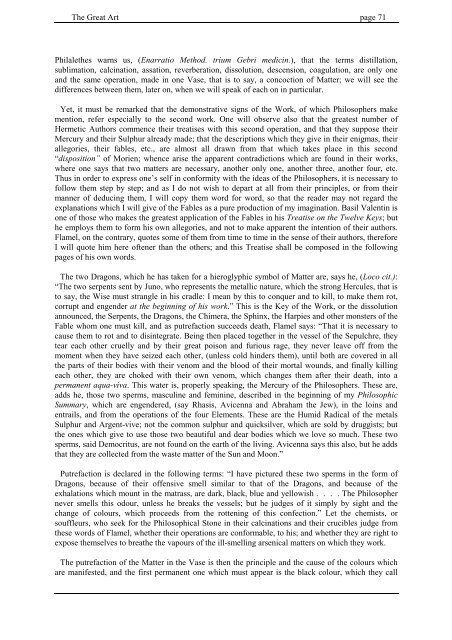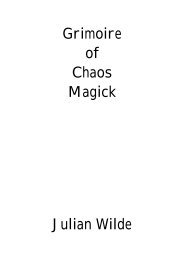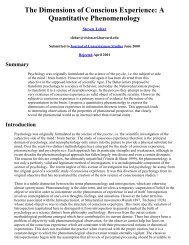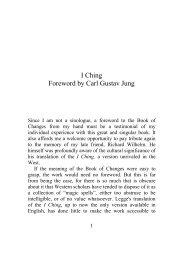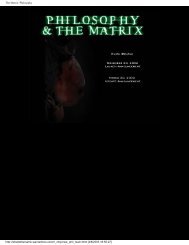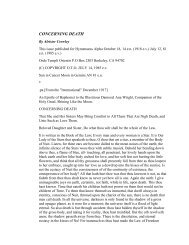Pernety - A Treatise On The Great Art.pdf - cyjack.com
Pernety - A Treatise On The Great Art.pdf - cyjack.com
Pernety - A Treatise On The Great Art.pdf - cyjack.com
Create successful ePaper yourself
Turn your PDF publications into a flip-book with our unique Google optimized e-Paper software.
<strong>The</strong> <strong>Great</strong> <strong>Art</strong> page 71Philalethes warns us, (Enarratio Method. trium Gebri medicin.), that the terms distillation,sublimation, calcination, assation, reverberation, dissolution, descension, coagulation, are only oneand the same operation, made in one Vase, that is to say, a concoction of Matter; we will see thedifferences between them, later on, when we will speak of each on in particular.Yet, it must be remarked that the demonstrative signs of the Work, of which Philosophers makemention, refer especially to the second work. <strong>On</strong>e will observe also that the greatest number ofHermetic Authors <strong>com</strong>mence their treatises with this second operation, and that they suppose theirMercury and their Sulphur already made; that the descriptions which they give in their enigmas, theirallegories, their fables, etc., are almost all drawn from that which takes place in this second“disposition” of Morien; whence arise the apparent contradictions which are found in their works,where one says that two matters are necessary, another only one, another three, another four, etc.Thus in order to express one’s self in conformity with the ideas of the Philosophers, it is necessary tofollow them step by step; and as I do not wish to depart at all from their principles, or from theirmanner of deducing them, I will copy them word for word, so that the reader may not regard theexplanations which I will give of the Fables as a pure production of my imagination. Basil Valentin isone of those who makes the greatest application of the Fables in his <strong>Treatise</strong> on the Twelve Keys; buthe employs them to form his own allegories, and not to make apparent the intention of their authors.Flamel, on the contrary, quotes some of them from time to time in the sense of their authors, thereforeI will quote him here oftener than the others; and this <strong>Treatise</strong> shall be <strong>com</strong>posed in the followingpages of his own words.<strong>The</strong> two Dragons, which he has taken for a hieroglyphic symbol of Matter are, says he, (Loco cit.):“<strong>The</strong> two serpents sent by Juno, who represents the metallic nature, which the strong Hercules, that isto say, the Wise must strangle in his cradle: I mean by this to conquer and to kill, to make them rot,corrupt and engender at the beginning of his work.” This is the Key of the Work, or the dissolutionannounced, the Serpents, the Dragons, the Chimera, the Sphinx, the Harpies and other monsters of theFable whom one must kill, and as putrefaction succeeds death, Flamel says: “That it is necessary tocause them to rot and to disintegrate. Being then placed together in the vessel of the Sepulchre, theytear each other cruelly and by their great poison and furious rage, they never leave off from themoment when they have seized each other, (unless cold hinders them), until both are covered in allthe parts of their bodies with their venom and the blood of their mortal wounds, and finally killingeach other, they are choked with their own venom, which changes them after their death, into apermanent aqua-viva. This water is, properly speaking, the Mercury of the Philosophers. <strong>The</strong>se are,adds he, those two sperms, masculine and feminine, described in the beginning of my PhilosophicSummary, which are engendered, (say Rhasis, Avicenna and Abraham the Jew), in the loins andentrails, and from the operations of the four Elements. <strong>The</strong>se are the Humid Radical of the metalsSulphur and Argent-vive; not the <strong>com</strong>mon sulphur and quicksilver, which are sold by druggists; butthe ones which give to use those two beautiful and dear bodies which we love so much. <strong>The</strong>se twosperms, said Democritus, are not found on the earth of the living. Avicenna says this also, but he addsthat they are collected from the waste matter of the Sun and Moon.”Putrefaction is declared in the following terms: “I have pictured these two sperms in the form ofDragons, because of their offensive smell similar to that of the Dragons, and because of theexhalations which mount in the matrass, are dark, black, blue and yellowish . . . . <strong>The</strong> Philosophernever smells this odour, unless he breaks the vessels; but he judges of it simply by sight and thechange of colours, which proceeds from the rottening of this confection.” Let the chemists, orsouffleurs, who seek for the Philosophical Stone in their calcinations and their crucibles judge fromthese words of Flamel, whether their operations are conformable, to his; and whether they are right toexpose themselves to breathe the vapours of the ill-smelling arsenical matters on which they work.<strong>The</strong> putrefaction of the Matter in the Vase is then the principle and the cause of the colours whichare manifested, and the first permanent one which must appear is the black colour, which they call


